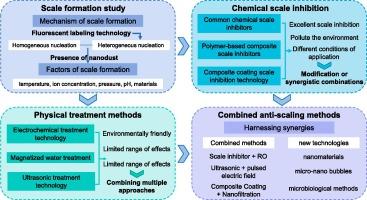Calcium sulfate scale control technology for circulating cooling water systems: A review
IF 5.9
3区 工程技术
Q1 CHEMISTRY, MULTIDISCIPLINARY
Journal of Industrial and Engineering Chemistry
Pub Date : 2025-05-15
DOI:10.1016/j.jiec.2025.05.029
引用次数: 0
Abstract
The presence of calcium sulfate scale corrodes piping and other equipment in circulating cooling systems, seriously jeopardizing the stable operation of circulating cooling water systems. Traditional scale inhibition methods face challenges in balancing efficiency and environmental impact, and advanced scale inhibition strategies are needed. In this paper, two different calcium sulfate scaling principles and the scale inhibition mechanism of scale inhibitors are discussed in depth, and the application of fluorescent labeling technology in scale inhibition research is described, and chemical scale inhibition methods, physical scale prevention methods, and combined anti-scaling methods are systematically analyzed. A synergistic strategy combining chemical and physical methods is proposed to achieve more significant synergistic effects; emerging scale inhibition technologies are developed to realize green characteristics and efficient scale inhibition performance. This will provide experience and inspiration for scale inhibition methods and descaling technologies for other scaling salts to ensure efficient operation of circulating cooling water systems and realize safe and stable industrial production.

循环冷却水系统硫酸钙结垢控制技术综述
硫酸钙水垢的存在会腐蚀循环冷却系统中的管道等设备,严重危害循环冷却水系统的稳定运行。传统的阻垢方法在平衡效率和环境影响方面面临挑战,需要先进的阻垢策略。本文深入探讨了两种不同的硫酸钙结垢原理和阻垢剂的阻垢机理,并阐述了荧光标记技术在阻垢研究中的应用,系统分析了化学阻垢方法、物理防垢方法和联合防垢方法。提出化学与物理相结合的协同策略,实现更显著的协同效应;开发新型阻垢技术,实现绿色环保和高效阻垢性能。这将为其他结垢盐的阻垢方法和除垢技术提供经验和启示,以保证循环冷却水系统的高效运行,实现工业生产的安全稳定。
本文章由计算机程序翻译,如有差异,请以英文原文为准。
求助全文
约1分钟内获得全文
求助全文
来源期刊
CiteScore
10.40
自引率
6.60%
发文量
639
审稿时长
29 days
期刊介绍:
Journal of Industrial and Engineering Chemistry is published monthly in English by the Korean Society of Industrial and Engineering Chemistry. JIEC brings together multidisciplinary interests in one journal and is to disseminate information on all aspects of research and development in industrial and engineering chemistry. Contributions in the form of research articles, short communications, notes and reviews are considered for publication. The editors welcome original contributions that have not been and are not to be published elsewhere. Instruction to authors and a manuscript submissions form are printed at the end of each issue. Bulk reprints of individual articles can be ordered. This publication is partially supported by Korea Research Foundation and the Korean Federation of Science and Technology Societies.

 求助内容:
求助内容: 应助结果提醒方式:
应助结果提醒方式:


